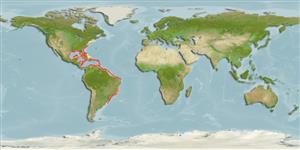Environment: milieu / climate zone / depth range / distribution range
Ecologia
marino demersale; oceanodromo (Ref. 51243); distribuzione batimetrica 55 - 525 m (Ref. 5222). Tropical; 43°N - 34°S, 98°W - 35°W
Western Atlantic: Massachusetts, USA to the Gulf of Mexico, Cuba, Trinidad, Rio de Janeiro and Sao Paulo (Ref. 47377), Brazil. Rare in the West Indies (Cuba, Haiti, and Trinidad). Reports from the eastern Pacific are apparently misidentifications of Epinephelus exsul.
Size / Peso / Age
Maturity: Lm ? range ? - ? cm
Max length : 230 cm TL maschio/sesso non determinato; (Ref. 5222); peso massimo pubblicato: 198.1 kg (Ref. 4699); Età massima riportata: 91 anni (Ref. 127586)
Spine dorsali (totale): 10; Raggi dorsali molli (totale): 13-15; Spine anali 3; Raggi anali molli: 9. Distinguished by the following characteristics: dark reddish brown or brownish grey to almost black dorsally, dull reddish grey below; depth of body contained 2.4-2.6 times in SL; head length 2.1-2.5 times in SL; distinctly convex interorbital area; angular preopercle, rounded angle, with slightly enlarged serrae and with 1-2 small spines on lower edge just in front of angle; smooth interopercle and subopercle; subequal nostrils, posterior nostrils slightly larger; maxilla reaches well past eye; 4-5 rows of small teeth on midside part of lower jaw in adults and juveniles with 2-3 rows (Ref. 89707).
A solitary species (Ref. 26340) usually found on rocky bottoms; juveniles are occasionally seen on jetties and shallow reefs (Ref. 89707). Adults feed on a variety of crabs, shrimps, lobsters, and fishes. Marketed fresh.
Life cycle and mating behavior
Maturità | Riproduzione | Deposizione | Uova | Fecundity | Larve
Craig, M.T. and P.A. Hastings, 2007. A molecular phylogeny of the groupers of the subfamily Epinephelinae (Serranidae) with revised classification of the epinephelini. Ichthyol. Res. 54:1-17. (Ref. 83414)
IUCN Red List Status (Ref. 130435)
Threat to humans
Harmless
Human uses
Pesca: commerciale; Pesce da pesca sportiva: si
Informazioni ulteriori
BibliografiaAcquacolturaProfilo di acquacolturaVarietàGeneticaElectrophoresesEreditarietàMalattieElaborazioneNutrientsMass conversion
Strumenti
Special reports
Download XML
Fonti Internet
Estimates based on models
Preferred temperature (Ref.
123201): 13.8 - 23.1, mean 18.3 °C (based on 82 cells).
Phylogenetic diversity index (Ref.
82804): PD
50 = 0.5001 [Uniqueness, from 0.5 = low to 2.0 = high].
Bayesian length-weight: a=0.01318 (0.00685 - 0.02536), b=3.05 (2.89 - 3.21), in cm total length, based on LWR estimates for this species & Genus-body shape (Ref.
93245).
Trophic level (Ref.
69278): 4.0 ±0.61 se; based on food items.
Resilienza (Ref.
120179): Basso, tempo minimo di raddoppiamento della popolazione 4.5 - 14 anni (K=0.05-0.14; tmax=24).
Fishing Vulnerability (Ref.
59153): High to very high vulnerability (67 of 100).
Climate Vulnerability (Ref.
125649): High to very high vulnerability (75 of 100).
Nutrients (Ref.
124155): Calcium = 40.6 [19.0, 78.0] mg/100g; Iron = 0.705 [0.364, 1.349] mg/100g; Protein = 18.1 [16.2, 19.8] %; Omega3 = 0.233 [0.128, 0.425] g/100g; Selenium = 129 [65, 268] μg/100g; VitaminA = 8.85 [3.12, 28.03] μg/100g; Zinc = 0.619 [0.422, 0.939] mg/100g (wet weight);
